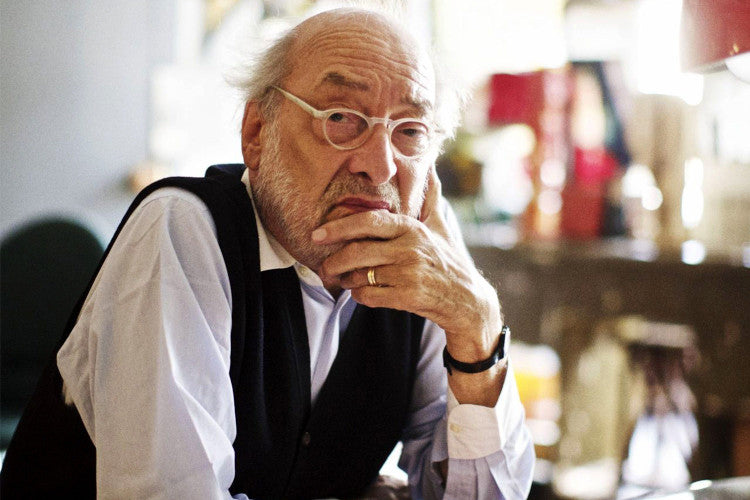
Gaetano Pesce
Gaetano Pesce is a major figure in Italian and world design of the 1950s. His work is as polymorphous as it is rich.
He is indeed called an architect, designer, painter, sculptor, stylist, scenographer, professor and contemporary philosopher.
Gaetano Pesce travels through history through strong, innovative, colorful pieces. His creations are intended to be both functional and garish, filled with humor or sometimes even shocking.
His works as an architect demonstrate his taste for innovation through the use of atypical materials and colors. He frequently uses resin, recycled paper or plastic. The Pink Pavilion, an entirely pink building constructed from rigid polyurethane, insulating against heat and cold, has excluded the usual construction materials. His best-known architectural work is the Organic building in 1993 in Osaka, Japan: a sort of prefabricated “pocket” containing earth and anchored into the wall, creating a vertical garden. With this concept, Pesce wanted a living building, changing color with the seasons.
Among his works of design, always committed and radical, we note the UP5 Donna armchair: a sculptural foam armchair representing a woman's body chained to a ball, the Golgotha chair alluding to the shroud of Christ, then its chador lamp symbol of the Islamic veil .
The objects he creates must go beyond their status as useful objects, they must create surprise. Through his work, Gaetano Pesce invented the unique example created within a series of similar products, because they were made with the same mold. The Italian master rightly describes this process as a “diversified or
“pluralist”.
We could criticize it for an unfinished or imperfect design, but this is precisely what Pesce is looking for: manufacturing defects become the mark of a search for authenticity, in reaction to standardization.
he knew how to create unique, colorful pieces, as if filled with vitality.
He opposes the standardization of our consumer society to reveal the authenticity of its objects. For him, it is only through originality that an object can convey emotions.
His work is recognized throughout the world and is permanently exhibited at the MoMA in New York, the Center Pompidou, the Louvre, and in other museums in London, Germany and San Francisco.
1/ Quelle est l’œuvre la plus célèbre de Gaetano Pesce ?
L’œuvre la plus impressionnante de Gaetano Pesce est sans aucun doute l’immeuble qu’il a construit à Osaka, au Japon. Construit en 1993, cet organic building est recouvert d’un jardin vertical. Dans les pots de fleurs qui recouvrent les façades, ce sont plus de 80 variétés de plantes qui poussent, dont beaucoup de bambous. Bâtiment emblématique de la ville d’Osaka, il accueille principalement des bureaux. Il est l’un des plus imposants exemples de l’éco architecture à l’heure actuelle. Découvrez les plus beaux vases de Gaetano Pesce sur notre site !
2/ Qu’est-ce qui caractérise les œuvres de Gaetano Pesce ?
Les œuvres de Gaetano Pesce se distinguent par leur caractère innovant et non conventionnel. En tant que designer, Pesce est connu pour repousser les limites de la créativité en utilisant des matériaux inhabituels, tels que la résine, pour créer des meubles et des objets aux formes organiques et surprenantes. Sa philosophie est centrée sur l'expression de la diversité et de la complexité de la vie à travers ses créations. Pesce privilégie la fonctionnalité tout en intégrant des éléments artistiques et conceptuels. Ses œuvres reflètent souvent une fusion unique de l'art, de la technologie et de l'individualité. Cette approche novatrice lui a valu une reconnaissance mondiale dans le domaine du design.
3/ Qu’est-ce que la série « Golgotha » de Gaetano Pesce ?
La série Golgotha de Gaetano Pesce est une suite de chaises et bureau. Créée en 1972, elle aborde le sujet de la religion ; pour Pesce, le design ne doit pas se limiter à l’utile mais questionner. La création de ce mobilier n’est pas ordinaire : la structure, en fibre de verre et dacron, est plongée dans un bain de résine ; ainsi, la forme des pièces créées est particulièrement inventive. D’après l’artiste, cette œuvre fait allusion au suaire de Turin ; le « drapé » du tissu en résine dépend de la manière dont la pièce a été plongée dans la résine, ce qui en fait une pièce aléatoire.
4/ Qu’est-ce que le Pink Pavilion de Gaetano Pesce ?
Le Pink Pavilion de Gaetano Pesce est une œuvre architecturale et artistique unique. Situé dans le quartier du SoHo à New York, il s'agit d'un immeuble aux formes organiques et fluides, construit en 2000. Cette structure rose vif reflète le style audacieux et non conventionnel de Pesce, avec des courbes inhabituelles et des éléments sculpturaux. Le Pink Pavilion est devenu un symbole emblématique de l'art et du design contemporains à New York, attirant l'attention des amateurs d'art et de design du monde entier. Cette création de Gaetano Pesce incarne son engagement en faveur de l'expression artistique et de l'expérimentation architecturale.
5/ Qu’est-ce que la collection « Fish Design » de Gaetano Pesce ?
Fish Design est une collection de vase ne résine créés par Gaetano Pesce au début des années 2000. Ces vases sont le parfait mélange entre fabrication artisanale et utilisation de matériaux innovants ; en effet, tous les modèles de la série sont fabriqués à la main, en Italie. La résine est travaillée de la même façon que si c’était de l’argile ; des techniques de sculpteurs sont utilisées pendant le processus de fabrication. Les pièces créées offrent une grande diversité de formes et de couleurs, ce qui en fait des pièces uniques ; c’est encore là une preuve que Gaetano Pesce veut promouvoir le « design imparfait ».
Voir plus















































